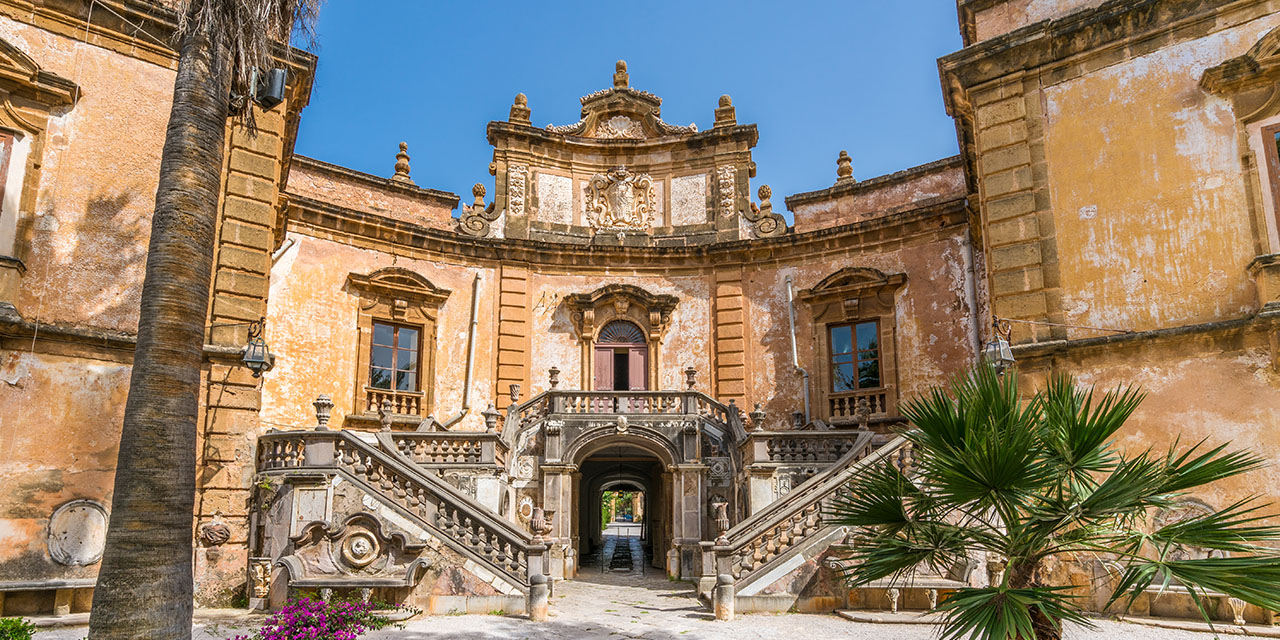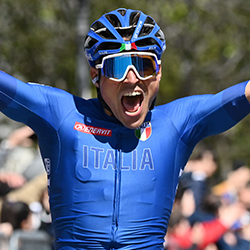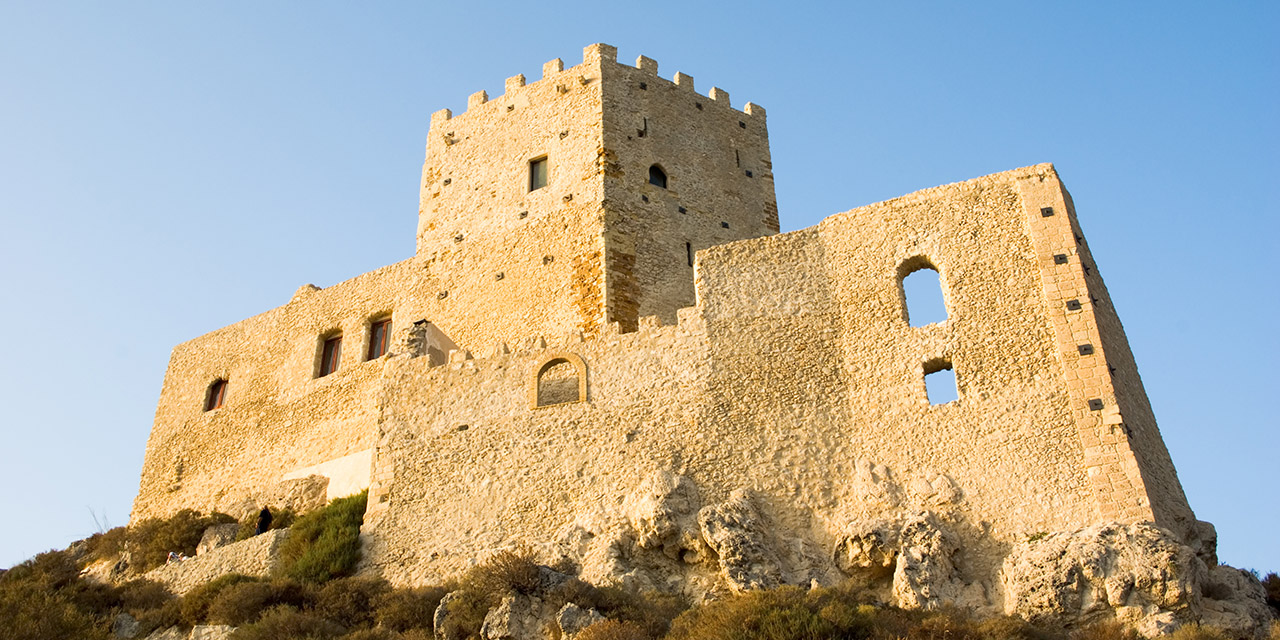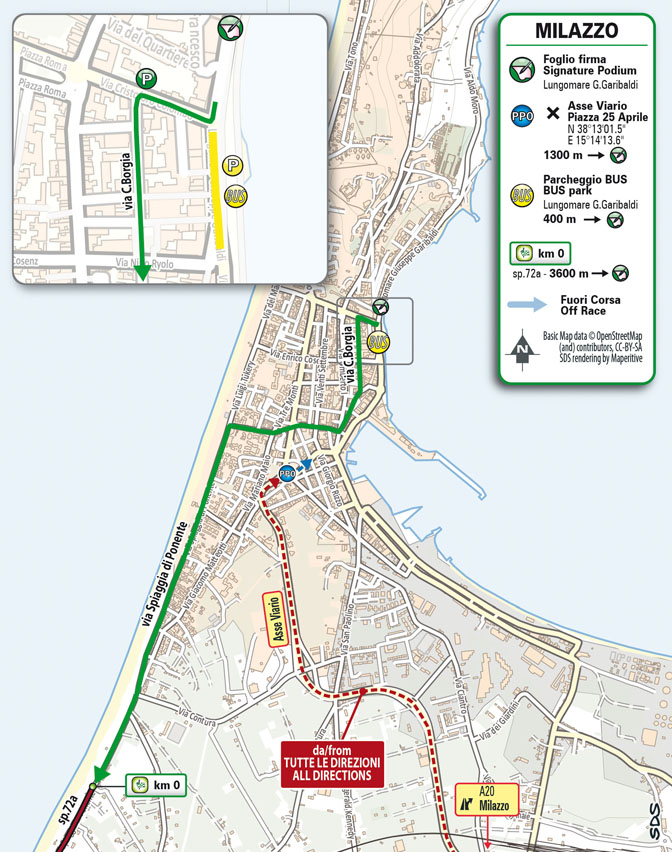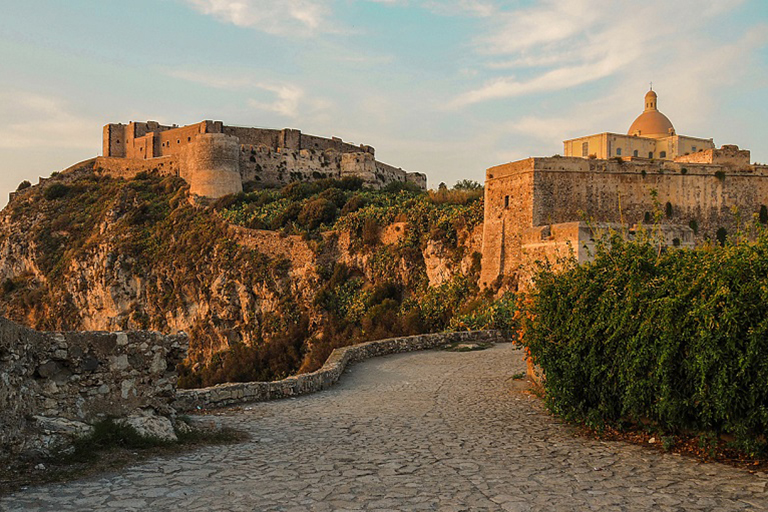profile
map
technical info
The route
The route is wavy, curved and undulating. With the exception of a few kilometres after the start, the stage is played out on the ss. 13, which runs along the northern coast of Sicily. A short, manageable climb up to Tindari after 30 km will be the only topographical impediment, along with a short, steep ascent to Termini Imerese, where sprint points will be up for grabs. A fast final stretch will lead to a bunch sprint.
Final kilometres
With 3 km to go, the route leaves the ss 113 and enters urban Bagheria. With 2,400 m to go, the route takes a left-hand turn followed by a right-hander, leading to a wide bend of nearly 1 km on a broad road. There is one last bend leading into the large home straight (350 m), on tarmac. The final kilometres are on a slight incline (average gradient, 1.5%).
start / finish
final kilometres
itinerary timetable
tourist info
Host city:
Milazzo
Touristic information
Sitting on a strip of land that emerges from the Tyrrhenian Sea, with the old town rising on a hill behind the port, Milazzo dominates the channel between Sicily and the Aeolian Islands. It is one of the rare sites in the Mediterranean area where human presence dates back to 6,000 years ago, which has left a significant artistic legacy of previous civilisations: necropoles from the Bronze Age and the Greek and Hellenistic‑Roman periods; the sturdy reinforced walls surrounding the castle, which had been built around an earlier Arab‑Norman centre; the 17‑century cathedral; churches and monasteries dating to the 18th century; noble mansions and quaint houses overlooking the old alleys, and beautiful staircases descending towards the sea.
Nowadays, Milazzo is the major port for ferryboats departing for the Aeolian Islands. Tourist facilities include state‑of‑the‑art hotels, restaurants, traditional eateries and well-equipped beach resorts. With its rich historical heritage, and a program packed with cultural events all summer long, in the stunning scenery of the Teatro al Castello, the town is a perfect destination for nature and art enthusiasts.
Owing to its efficient land and sea infrastructures, Milazzo also serves as an ideal starting point for traveling to the Ionian and Tyrrhenian coasts of Sicily, from Siracusa to Palermo, from Cefalù to the Etna.
Ph. Credits Paolo Barone
Gastronomy
Viticulture is a thriving industry, which generate significant yields in terms of table grapes and prized wines, such as the Mamertino di Milazzo bianco Doc.
Local cuisine offers plenty of tasty specialties, and especially fish recipes, such as fish soups or squid ink pasta, and char-grilled or pan-seared fish. One of the hallmarks of local cuisine is pesce stocco alla messinese, or ‘alla ghiotta bianca’, made with stockfish (dried cod), white olives, capers, parsley and garlic. If you’re in the mood for something sweet, treat your taste buds to some crunchy piparelli (almond and honey biscuits).
Ph. Credits Paolo Barone
Points of interest
The old village (Borgo Antico) and the Upper Town (Città Alta)
The old town incorporates the medieval quarters and most of the religious buildings and, most notably, the sanctuary of S. Francesco da Paola. Built between 1456 and 1467, at the behest of St. Francis himself, and restored in the 18th century, the sanctuary now sports an elegant façade, with a sweeping staircase. Inside, it holds valuable artworks such as a 15-century sculpture of the Virgin Mary and Baby Jesus, by Domenico Gagini.
The town has many other fine churches, listed hereafter. The church of Immacolata, built in 1640, contains prized artwork, such as a 16-century alabaster statue of the Blessed Virgin Mary, which was probably sculpted by one of Gagini’s disciples. The beautiful church of SS. Salvatore, with its façade dating from 1755, designed by Giovan Battista Vaccarini, and its adjacent Benedictine convent, contains a statue of St. Benedict, the founder of the Order. Inside, it is decorated with beautiful frescoes by Scipio Manni, and with an 18-century altarpiece in the sacristy. Equally notable are the 16-century church of Madonna della Catena, and the church of S. Rocco, built in 1575, during the three-year plague epidemic that struck Sicily. The church of Madonna del Rosario, originally designed as a fortress church, stands opposite the main entrance of the castle, in a small square at the foot of a suggestive staircase. Built starting in 1538, along with the adjoining Dominican convent, it was also the seat of the Holy Inquisition. Inside, it holds many paintings dating to the 18th century. Last but not least, the single-nave church of S. Giuseppe, built in 1565 during the plague epidemic, sports a beautiful 18-century window on the main façade.
The Old Cathedral was built starting in 1608 to a design by Camillo Camilliani, a disciple of Michelangelo. Inaugurated in 1616, it was first dedicated to S. Maria Assunta in 1642, and later to St. Stephen, the First Martyr. When Victor Amadeus II, King of Sicily, visited the town, a Solemn Mass was held here, and the “Te Deum” was sung. The floorplan and the architecture of the church reflect the traditional canons of the Renaissance. When the church was deconsecrated, it was long neglected and ultimately vandalised in July 1860 (following the victory of Garibaldi’s army), which led to most of the furnishings and the interiors being destroyed.
A walk through the landmarks of the Old Village offers splendid views of aristocratic buildings dating from the 17th and 18th centuries. The Palazzo dei Viceré, which served as the residence of governors, viceroys and lieutenants, overlooks the ancient Salita S. Francesco with its beautiful late-Baroque façade.
The castle towers above the town, in a central position, surrounded by the Aragonese bastions and by the sturdy Spanish fortifications that once closed around the walled town, now deserted. The ruins of the Palazzo dei Giurati and the old Cathedral are the only remaining witnesses of the past. The cliff, rising sheer above the sea, has been settled since prehistoric times. A citadel was established under the Greeks, the Romans and the Byzantines. The present castle was built starting in the Arab and Norman periods. It was further expanded and reinforced under Frederik II, when it was given a square structure, with eight towers and a large central courtyard. Additional fortifications were added under the Aragonese Crown and the Spanish rule, and the castle became impregnable for centuries, until it was conquered by Garibaldi in the hardest and fiercest battle of the Expedition of the Thousand. The view from above is far-reaching, encompassing two gulfs and the strip in-between, the large beach to the west, the green lowlands, and the Peloritani Mountains in the background, with the snow-capped silhouette of Mt. Etna in the distance, and the steaming crater of nearby Stromboli, to the north.
If you travel along the western coast, all the way to Capo Milazzo, you’ll enjoy a sweeping view over the cliff, ranging from the Aeolian Islands, all the way to the coast of Calabria. A staircase leads to a small sanctuary, dedicated to St. Anthony of Padua, carved inside a cave. Walking up the staircase among the dry-stone walls and the prickly pears, heading towards the lighthouse, you will reach the edge of the promontory, among the wild olive trees and caper plants, with the scent of absinthe wormwood blown by the wind.
The city is part of a consortium called Circuito dei Borghi Marinari, which aims at promoting and protecting the sea, as well as its culture and customs.
Items and relics of the ancient seafaring traditions are on display at the Museo della Tonnara. The town also has a permanent wine museum, called the Museo Enologico “Grasso”, in which visitors can observe every step of winemaking, visit the vineyards and the cellars, and enjoy young wine tastings.
Ph. Credits Paolo Barone
Bagheria
Touristic information
A populous city in the province of Palermo, and hometown to the neorealist painter Renato Guttuso, Bagheria is famed for its beautiful historic villas and 18-century manor houses.
Ph. Credits Filippo Maria Tripoli
Gastronomy
The sfincione di Bagheria is the hallmark of local cuisine. This chunky and soft focaccia, unlike the one that is made in Palermo, is tomato-free. The recipe calls for a thick layer of tasty “tuma” (traditional local cheese), anchovies, ricotta, fried white onions, and toasted breadcrumbs with caciocavallo cheese. Despite traditionally being a Christmastime recipe, sfincione can actually be found all year round.
Ph. Credits Filippo Maria Tripoli
Points of interest
Villa Palagonia, also named Villa dei Mostri (literally, ‘the villa of monsters’) is one of the most famous historical manor houses of the town. Designed by eminent architects, it was a favoured destination for Grand Tour travellers back in the 1700s. Stately and quirky, it is decorated with ghastly tuff-stone statues of monsters sitting atop the garden walls. According to legend, Prince Ferdinando Francesco Gravina e Bonanni, the owner of the villa, had decided to populate the building with caricatures of friends and acquaintances as a way to exorcise his extreme ugliness.
Villa Valguarnera is a masterpiece of Italian 18-century architecture. The large oval hall, designed by Vaccarini, is decorated with frescoes and paintings by famous artists. The villa was also the set of a famous commercial by Dolce & Gabbana, directed by Giuseppe Tornatore, featuring music by Ennio Morricone and guest starring Sophia Loren.
Built in 1736, Villa Cattolica recalls a castle in style. Interestingly, there is an artificial rock shelter carved under the mansion to protect from the arid African winds, referred to as “Camera dello Scirocco” (which translates to “sirocco chamber”). Inside the villa, the Renato Guttuso Museum is a rich treasure trove of artworks by Guttuso himself and by other masters of contemporary art.
Palazzo Butera is the oldest noble mansion in Bagheria. It was originally conceived as a castle, with two crenelated towers guarding the courtyards. Its ornate salons, with frescoes and lavish crystal chandeliers, evoke the dance scene in L. Visconti’s The Leopard. Its beautiful balconies serve as an ideal vantage point for the fireworks show held on July 14 to celebrate Santa Rosalia.
A visit to the Museo del Giocattolo e delle Cere Pietro Piraino (toy and wax museum) in Bagheria, through collections of porcelain dolls, clockwork figures and old mechanical toys, is bound to take us back in time.
The seaside village of Aspra also deserves a special mention. This quaint little town is famed for its calcarenite limestone quarries, and is a leading world exporter of anchovies in salt and oil. Main attractions here include the Museo dell’Acciuga e delle Arti Marinare (museum of anchovies and seamanship).
Ph. Credits Filippo Maria Tripoli


